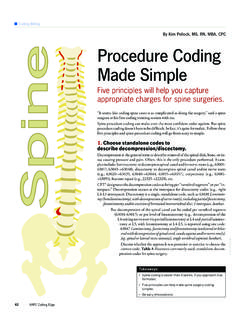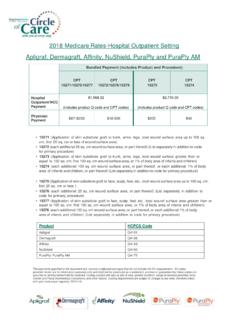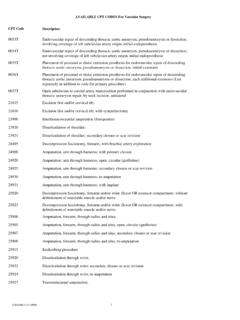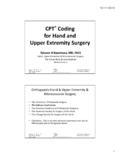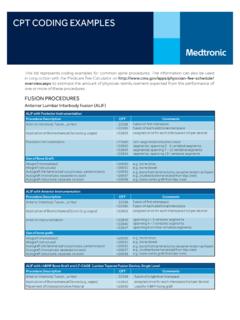Transcription of Spinal changes that have significant impact in …
1 Spinal changes that have significant impact in correct coding and documentation By: Margie Scalley Vaught CPC, CPC-H, CPC-I, CCS-P, PCE, MCS-P, ACS-EM, ACS-OR. Last year, 2011, CPT with the help of CMS combined the anterior fusion and anterior discectomy procedures into a combo code when performed together during the same encounter at the same Spinal level. Well we know that it was just going to be a matter of time before they bundled the two posterior lumbar arthrodesis codes. Sure enough for 2012 codes 22633 and 22632 were developed. 22633 Arthrodesis, combined posterior or posterolateral technique with posterior interbody technique including laminectomy and/or discectomy sufficient to prepare interspace (other than for decompression), single interspace and segment; lumbar 22634 Arthrodesis, combined posterior or posterolateral technique with posterior interbody technique including laminectomy and/or discectomy sufficient to prepare interspace (other than for decompression), single interspace and segment; each additional interspace and segment (List separately in addition to code for primary procedure).
2 The above codes are to be used whenever the surgeon is doing a PLIF and posterolateral arthrodesis at the same lumbar level. If combining them was not enough, CPT changed the guidelines relating to this section of the CPT manual stating that only ONE primary posterior lumbar arthrodesis code can be reported per session. What this means is that you are only going to be able to report ONE posterior lumbar arthrodesis code such as 22633 or 22612 or 22630 and then for each additional level you will use an add-on code. It does not matter what type of posterior lumbar arthrodesis is done the add-on codes for each additional level' (codes 22614 and 22632) can now be reported with any of the primary codes, 22612, 22630 or 22633. However it appears they did not extend the use with' definition for 22634 as it only states it can be reported with 22633.
3 Example Surgeon performs a PLIF and posterolateral lumbar arthrodesis at L1/2 and then does another double arthrodesis at L2/3 and then just a posterolateral arthrodesis at L3/4 and L4/5. The coding for 2012 will now be: 22633 for L1/2. 22634 for L2/3. 22614 for L3/4. 22614-59 for L4/5. The coding for 2011 would have been more of 22630 (L1/2); 22612 (L1/2)-59; 22632 (L2/3); 22614. (L2/3); 22614-59 (L3/4) and 22614-59 (L4/5). Deciding which primary to list first, 22633 vs. 22630 vs. 22612 will come down to the RVUs assigned. Code 22633 has approximately RVUs; 22630 has approximately and 22612 has approximately The subsection guidelines were revised stating: (Use 22614 in conjunction with 22600, 22610, 22612, 22630 or 22633 when performed at a different level. When performing a posterior or posterolateral technique for fusion/arthrodesis at an additional level, use 22614.)
4 When performing a posterior interbody fusion arthrodesis at an additional level, use 22632. When performing a combined posterior or posterolateral technique with posterior interbody arthrodesis at an additional level, use 22634. Use 22632 in conjunction with 22612, 22630, or 22633 when performed at a different level. When performing a posterior interbody fusion arthrodesis at an additional level, use 22632. When performing a posterior or posterolateral technique for fusion/arthrodesis at an additional level, use 22614. When performing a combined posterior or posterolateral technique with posterior interbody arthrodesis at an additional level, use 22634 (1) (2). The AMA/CPT clearly updated the add-on' code range guidelines and supported that in the CPT. changes An Insider's View 2012, but what about the instrumentation and grafting codes with 22633 and 22634?
5 In the publication An Insider's View 2012 they provided a scenario of 22633 and it clearly states that you can report separately for the grafting material and also instrumentation when placed. Following this, the intervertebral fusion graft material(s) (eg, allograft, autograft, intervertebral cage[s] are reported separately) are placed unilaterally or bilaterally as determined by the Spinal pathology. Following placement of the intervertebral graft, the transverse process, and/or facet are decorticated and graft material (reported separately) is placed posterolaterally for a fusion. If used, Spinal instrumentation is placed (reported separately) as an adjunct to fusion. The wound is irrigated and closed in layers with application of a sterile dressing (1). Unfortunately the actual CPT Official Guidelines for instrumentation and grafting were not updated to add the codes 22633 and 22634 to the range.
6 NASS and AAOS have both stated that this was clearly an oversight and that the AMA/CPT intent is clear in their publication that you can report and seek reimbursement for instrumentation and grafting with the new codes. However many payers/carriers have held a hard line stating that the guidelines do not state you can report the instrumentation/grafting codes with codes 22633 and 22634. If you are receiving denials for your instrumentation/grafting codes, you will want to appeal with the above information from the CPT. changes An Insider's View 2012 along with the Dec 2011 CPT Assistant: Question: When reporting code 22630, Arthrodesis, -posterior interbody technique, including laminectomy and/or discectomy to prepare interspace (other than for decompression), single interspace; lumbar, may bone grafting, instrumentation, or placement of intervertebral biomechanical device in the disk space be additionally reported?
7 Answer: Yes. The posterior interbody arthrodesis code 22630 may also require the additional performance of a posterior fusion, which involves bone grafting, and if indicated, placement of posterior instrumentation. When performed, the appropriate spine bone grafting add-on code(s). (20930-20938) and posterior instrumentation add-on code(s) (22840, 22842, 22843, 22844). should also be reported. If a posterior or posterolateral fusion technique is also performed at the same level, the procedure should be reported with the combined code 22633 instead of code 22630. In addition, carbon fiber, titanium, or polyetheretherketone (PEEK) cages (ie, intervertebral devices) should be reported with code 22851. Machined bone -products or allograft spacers would be reported with bone graft code 20931, Allograft, structural, for spine surgery only (List separately in addition to code for primary procedure) rather than code 22851, Application of intervertebral biomechanical device(s) (eg, synthetic cage(s), methylmethacrylate).
8 To vertebral defect or interspace (List separately in addition to code for primary procedure).". They have now released the errata (May 23, 2012) Add reference codes 22633 and 22634 to the parenthetical notes following the bone graft codes 20930-20938 to include the combined posterior or posterolateral arthrodesis codes 22633. and 22634. Add reference codes 22633 and 22634 to the parenthetical notes following the Spinal instrumentation codes 22840-22848 and 22851 to include the combined posterior or posterolateral arthrodesis codes 22633 and 22634.". Instrumentation Code Clarification Clarification was supplied in the official CPT Guidelines regarding the appropriate use of the insertion and removal Spinal instrumentation codes. Even though this clarification is now appearing in the 2012.
9 CPT Guidelines, it has been the policy of AMA/CPT; NASS and AAOS as well as CCI for many years. Now hopefully everyone will be on the same page. The big clarification is when it is appropriate to use and report 22849 as well as when is it appropriate to bill and report for removal of Spinal instrumentation if you are also placing new instrumentation. CPT code 22849 represents Reinsertion of Spinal fixation device. This code should only be reported when you are removing and replacing Spinal instrumentation at the EXACT same Spinal levels. Example: Patient had previous Spinal instrumentation at L1-4 and presents with concerns of possible pseudoarthrodesis. The surgeon removes the previous instrumentation at L1-4 and finds that they need to redo the fusion and thus places new instrumentation at L1-4.
10 In this case the ONLY instrumentation code reported would be 22849 the removal will be considered inclusive. Example: Patient had previous posterior Spinal instrumentation at L2-4 and presents with concerns of fusion issues. The surgeon removes the previous instrumentation at L2-4 and now places new instrumentation from L1-5. In this case the ONLY instrumentation code reported would be 22842. The removal gets bundled. Example: Patient had previous posterior Spinal instrumentation at L1-4 and presents with concerns of possible pseudoarthrodesis. The surgeon removes the previous instrumentation at L1-4 and finds that there is a solid fusion at L1/2 but problems with L2-4. They redo the fusion placing new instrumentation at L2-4. In this case the placing of the new instrumentation would be reported as 22842.

